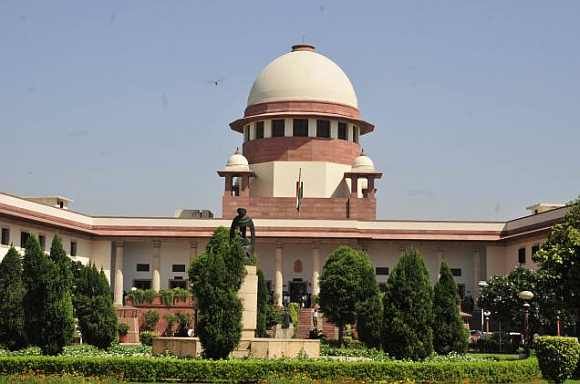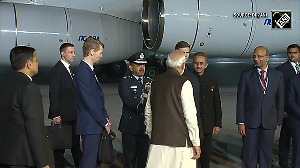 The nullifying of the NJAC Act has put the spotlight on the Judiciary.
The nullifying of the NJAC Act has put the spotlight on the Judiciary.
Concepts like transparency, being open to change, leading from the front, management of perceptions that were reserved for the Executive earlier are now relevant for the Judiciary as well, says Sanjeev Nayyar.
Now that the debate with respect to the scrapping of the National Judicial Appointments Commission Act, 2014 has ebbed, it is time to look at some issues affecting the judicial system dispassionately.
At the outset I must state that I amongst the millions who thank the courts for their judgements on scams like 2G and Coalgate, amongst others.
At various points the courts have asked the Executive to improve the quality of governance. While that is laudable note that there are 61,300 cases pending (external link) before the Supreme Court as on March 1.
Can the incoming Chief Justice of India let the nation know:
1. How does the Supreme Court propose to clear this backlog and within what time frame?
2. Key changes in procedures that will that lead to quicker disposition of cases?
3. What changes should be made to existing laws so as to reduce litigation?
The intent behind enlightening people is for better appreciation of the work being done, to initiate a debate on simplification of laws, bring transparency and make the system accountable.
Further, as per an NDTV report (external link) of December 7, 2014, 'The data available for the 24 high courts and lower courts up to the year ending 2013 showed pendency of 44.5 lakh and 2.6 crore respectively.'
Can the chief justice of every high court similarly publish action on points 1 to 3.
According to a Business Standard report (external link) World Bank country Director Onno Ruhl said on enforcing contracts, 'This is notoriously difficult because it deals with the judicial system.'
Also, Alok Prasanna Kumar, senior resident fellow at the Vidhi Centre for Legal Policy wrote, 'The two main areas where the World Bank's report faults India is in the time it takes to resolve a case, and the cost of enforcing a contractual claim.'
This link to the World Bank Group site gives ranking in 'Enforcing Contracts'. It indicates time taken for trial and judgement at 1,095 days and enforcement of judgement 305 days, quality of judicial processes has a score of 7.5 out of 18. India's ranking (external link) in enforcement of contracts has to improve if India has to better its rankings in the Ease of Doing Business. The judiciary and the law ministry must work together to find solutions.
Is the judiciary over extending itself?
1. Recently, Maharashtra Chief Minister Devendra Fadnavis, in order to save energy, ordered replacement of yellow sodium vapour lights on Mumbai's iconic Marine Drive with energy efficient white LED lights. In response to a PIL, the Bombay high court ordered that instead of sodium lamps, the state should use yellow LED lights since that golden glow should remain on the Queen's Necklace.(Source)
According to this Hindustan Times report (eexternal link), in response to a PIL urging the reservation of a separate compartment for senior citizens the Bombay high court asked, 'Why do so many people travel towards South Mumbai each day? Why are local trains so overcrowded during non-peak hours? The court has directed the Maharashtra government and the railways to conduct a survey to understand its daily passenger demographic on local trains.'
Without getting into the merits or demerits, what is the matter of law in these cases? Should courts be concerned with the colour of lights or passenger traffic?
2. Delhi's polluted air: According to this Business Standard editorial (external link, 'The National Green Tribunal's recent ruling imposing what is in effect a tax on diesel-powered trucks and light commercial vehicles entering the capital, later confirmed by the Supreme Court. Anything between 22,000 and 38,000 trucks use these entry points every night.'
Collection of tax would require vehicles to stand in long lines, 'combustion engines emit considerably more when idling in traffic than otherwise, it is far from clear how much of a net positive for the air the collection of this tax by contractors would be.'
Imposition of this tax would increase living costs, a decision for which the NGT is not accountable to the common man. It might have been better for the Supreme Court to urge the respective state governments to complete the much-needed bypass network in a time-bound manner.
3. Court raps govt over rising farmers' deaths in Marathwada region: According to a Hindustan Times report of October 8, 'the Bombay high court issued notice to the state government seeking its response to the alarming rise in instances of farmers committing suicides in the Marathwada region. The two honourable judges sought a detailed ground report from the state.'
'The high court also directed the government to enlist steps it has taken so far -- particularly details of efforts for assisting farmers in repaying bank loans, availing of new loans, conserving water and in growing non-water intensive crops to help farmers in the region.'
Whilst appreciating the court's concern, does this fall under the domain of the Judiciary?
Courts have provided relief in many cases when citizens were faced with an indecisive or insensitive government for example, 'Courts intervened in the Ram Setu case arising out of the government's refusal to pay heed people's concerns about its effect on environment and their religious concerns, land acquisition in Singur as matters took an ugly turn.' (Source)
Sometimes courts are the last resort for citizens. According to this Hindustan Times report (external link), 'The Akhil Maharashtra Machchhimar Kruti Samiti has approached the court, challenging closure of the age-old fishing port at Girgaum chowpatty by the Maharshtra government.'
4. Columnist M J Antony recently wrote (external link), 'Despite 65,000 cases in arrears, the court has enough adrenaline to consider issues such as ban on Sardarji jokes on Web sites, polygamy among Muslims and creating a safe corridor for wild elephants crossing rail lines.'
Is a review of priorities the need of the hour?
5. Supreme Court notice to Centre over improper implementation of MGNREGA. According to this Business Standard report (external link) the Supreme Court today took note of a PIL alleging improper implementation of the National Rural Employment Guarantee Act in terms of timely payment of wages and compensation and asked the government to make the payments promptly.
'States should wake up and make prompt payments,' a bench comprising Chief Justice H L Dattu and Justice Amitava Roy said while issuing notice to the ministry of rural development.'
Did those who wrote the Constitution envisage that the Supreme Court would be asking governments to make timely payments? The question that an aam aadmi may ask is, whether there is a dispute between parties or does this matter involve interpretation of law and how does timely payment of wages concern the Supreme Court?
Can the Supreme Court increase transparency? A few examples of what can be done:
1. According to a article (external link) in The Hindu, 'The Supreme Court claimed before the Central Information Commission that declaration of assets by the judges before the chief justice was "voluntary" as per the resolution adopted by full bench of the Supreme Court in 1997 and cannot be accessed by public under the Act.'
As on November 13, out of the 28 Supreme Court judges, 24 have voluntarily declared their assets on the Supreme Court Web site (external link). The high court Web sites of Bombay, Calcutta, Allahabad, Guwahati, Patna do not disclose assets of judges whilst those Madras, Bangalore, Delhi do.
A couple of humble suggestions
1. The Judiciary should make it mandatory for all Supreme and high court judges to declare their assets and have them published on respective Web sites. In all cases, the statement of assets must indicate it is as of what date. Also, it should be updated every five years just like new members of Parliament do.
2. According to this Indian Express report (external link) of July 2012, 'Of the 21 judges to have retired from the Supreme Court since January 2008, 18 got jobs in different government commissions and tribunals.'
Can the Supreme Court draft guidelines on appointment of judges post-retirement.
3. According to this Indian Express report of October 2015, 'The high court judge who stopped Himachal Chief Minister Virbhadra Singh arrest was his former lawyer: CBI to Supreme Court.'










